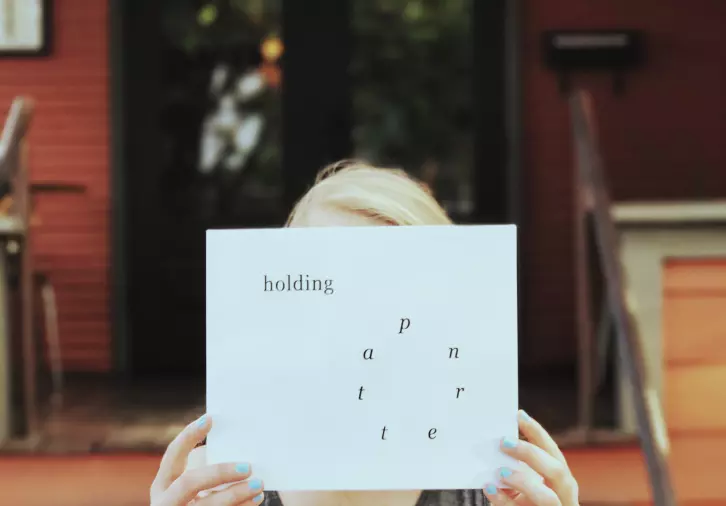Termites skittering down lines of the nervous system, traced on exposed skin. A thin, red outline of shelter against a wintry landscape. Racist legislation projected onto hung cloth, set in phantasmal glow.
These are the subjects of Volume One of the Dallas-based arts publication Holding Pattern. The annual publication created by DADE Collective is a platform for non-male makers, as described in DADE’s mission statement. The term non-male is presented to be as inclusive as possible; Holding Pattern is for female-identifying as well as non-binary artists.
Originally, Volume One was promoted through a network of creatives. The call for submissions was for female-identifying artists. Since then, the call has changed to reflect the complexity and nuance of gender in our society.
“We wanted to open it up. And that’s part of not representing a monolith of women. Cis women don’t own womanhood. Trans women don’t own womanhood. Womanhood isn’t a neat little container,” Collective member D S Chapman said. “Femininity and the aspects of womanhood – or things that we would categorize as womanly – exist within non-binary people as well. There’s a lot more fluidity.”
DADE Collective consists of four artists: Diana Antohe, Angelica (Angie) Reisch, D S Chapman, and Ellen Smith. “DADE” is simply the artists’ first initials, but the word ‘dade’ also means to lead and support, as a caretaker would to a child or a member of the older generation to the younger.
Antohe spontaneously came up with the title Holding Pattern. Back then, Antohe and Smith had graduated from SMU, while Chapman and Reisch were still completing their senior years. Catalyzed by the 2017 Women’s March, the collective wanted to showcase work from women artists. Between classes and on weekends, the four were laying the groundwork for this. But at that time, there wasn’t a name for it, and they still thought it was going to be an exhibition – not a publication.
“Every one of us were emailing people constantly requesting gallery spaces. It was a long and arduous process,” Smith said.
While drafting yet another email for another exhibition, Antohe remarked it felt like they were in a holding pattern.
A holding pattern is the pattern a plane flies while it waits for permission to land. The term evokes a sense of lingering suspension.
Not only did ‘holding pattern’ describe the challenging process behind requesting space, it reflected the body of work they were presenting and the spirit behind it. The publication of Holding Pattern would become the release of long-awaited perspectives and representation.
“I think the nice thing about that phrase is that, while it does come from a place of frustration, suspension or waiting, it does also encapsulate a bit of hope,” Reisch said. “There will be a space available at some point; it’s just a matter of when you will receive that permission to land. So, it’s not an entirely hopeless term.”
Isolated, the term “holding pattern” also sounds nurturing and supportive to Antohe. “It evokes weaving for me: something that’s meant to hold you,” Antohe said. The collective liked the duality of the evocative term.
The second volume will be more curated and reflective of the theme. This year, the collective asked artists and writers to examine the holding patterns within their own lives and practices.
“Every single person who submitted really took that to heart and sent us things they’ve really been struggling with. Things they’ve been working on forever. The projects they loved that have never been shown,” Smith said. “We got some really amazing and some really crazy touching, emotional pieces.”
During the hunt for exhibition, the collective realized it made more sense for Holding Pattern to be a publication than an exhibit. The release of Volume One was paired with a book launch at Wild Detectives with Toxic Shock, a group of female artists who worked together in the 1980s.
“I think it’s important for us to remember this isn’t new. Women haven’t been fighting for space – fighting for representation – for the past couple of years. We’ve been at it for decades. We’ve been at it for centuries,” Smith said.
DADE has received a grant from the Dallas Museum of Art and a microgrant from the Nasher Sculpture Center. This money helped commission writers to enrich the publication. After last year’s 36-page publication, this year’s Volume Two will be 150 pages. DADE also continues their search for exhibition.
“I will say, I think that our struggle to find a space is not an isolated experience. Space, in general, is so difficult to find. They just released the final draft of the Dallas Cultural Plan outlining what are the top arts and cultural issues in our community,” Reisch remarked. Reisch said the Dallas Cultural Plan lists physical space among its top priorities. It’s an issue happening in a lot of places, but in Dallas especially.
In the interim, DADE works to raise money to print Volume Two and further discussion for exhibition. This is their new holding pattern.





